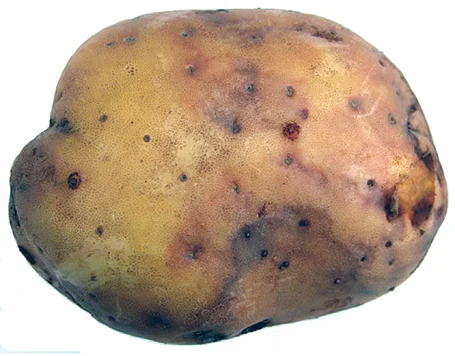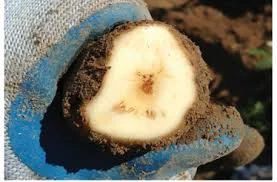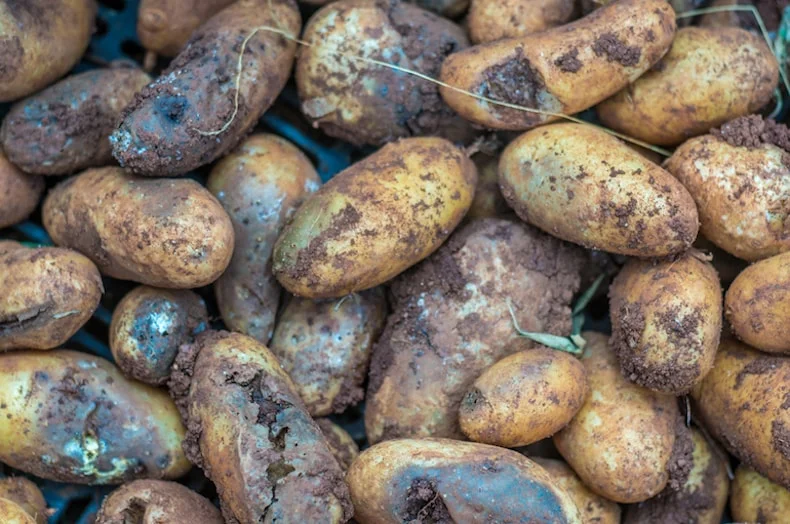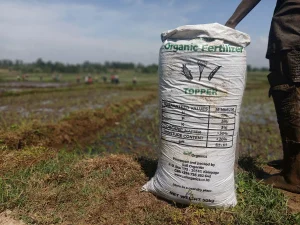
Potatoe farming is a profitable venture in many parts of the world from Europe to Africa. Despite its profitability, potato farming has numerous challenges such as the use of poor-quality seeds and diseases. Potatoe diseases, if not controlled early, can decimate an entire farm causing huge losses to potato farmers.
This article will discuss the major 10 potatoe diseases that affect potato farmers worldwide. We will discuss how to identify these diseases and solutions to contain them.
10 Potatoe Diseases to Know About and Solutions
- Potatoe Late Blight
- Potato Early Blight disease
- Black Scarf disease
- Potato Scab
- Fusarium Dry Rot
- Verticillium Wilt
- Bacterial Soft Rot
- Potato Leaf Roll Virus
- Common Mosaic Virus
- Powdery Scab
1. Potato Late Blight Disease
Potatoe Late blight disease is caused by the pathogen Phytophthora infestans, which is a devastating disease that can severely impact potato crops.
Symptoms of Potato Late Blight Disease
Initial symptoms include dark, water-soaked spots on the leaves that rapidly expand under cool, moist conditions.
As the disease progresses, white, fuzzy mold may appear on the undersides of the leaves, particularly in humid environments. Potato Stems can also develop brown to black lesions, leading to them to collapse.
In addition, Infected potato tubers exhibit firm, brownish rot that often starts at the surface and penetrates deep into the tuber, accompanied by a distinctive, unpleasant odor.
Late Blight Disease Solutions
Effective management of late blight disease involves a combination of cultural practices, chemical control, and sanitation.
For example, avoid planting tomatoes, in the same area more than once every three years to reduce soil-borne inoculum. In addition, ensure proper spacing between plants to improve air circulation. This reduces humidity, thereby mitigating the spread of the diseases.
Also, remove and destroy plant debris after harvesting to eliminate potential sources of infection.
Lastly, late potato blight disease can also be controlled using Chemical control through the application of fungicides such as chlorothalonil, mancozeb, or copper-based products.
2. Potato Early Blight disease
Early blight potato disease caused by the fungus Alternaria solani, is a common potato disease characterized by several distinct symptoms. Initially, small, dark brown to black spots appear on the lower leaves.
Similarly, the spots often have concentric rings, giving them a “target spot” appearance. As the disease progresses, the areas around these spots turn yellow, leading to withering and defoliation. Infected stems and leaf petioles may develop dark, sunken lesions that can girdle the stem, weakening and potentially collapsing the plant.
Potato tubers can also be affected, developing dark, sunken lesions with a firm texture. This rot can extend into the tuber, causing internal browning, thus reducing their marketability.
Solutions for Potatoe Early Blight Disease
Managing early blight effectively involves a combination of cultural practices, chemical control, and sanitation.
Crop rotation is also crucial to prevent the buildup of funguses in the soil. Furthermore, potatoes should not be planted in the same location more than once every three years.
After harvesting potatoes, remove and destroy all plant debris to reduce the chances of infection. Proper plant spacing improves air circulation, reducing humidity around the foliage and lowering the risk of disease.
Another solution is to use chemical control methods such as the application of fungicides like azoxystrobin, boscalid, or chlorothalonil. These should be applied at regular intervals, especially during humid conditions.
Lastly, potato farmers should implement proper Irrigation practices such as Watering plants early in the day, to allow foliage to dry quickly.
Another strategy would be to use some of the best fertilizers for potatoes such as Safi Sarvi which includes essential nutrients such as nitrogen and potassium. Fertilizers in calcium enable the potatoes to have strong cell walls which keeps diseases at bay.
3. Potatoe Black Scarf Disease
Black scurf, caused by the soil-borne fungus Rhizoctonia solani, is a prevalent disease affecting potatoes. This disease primarily targets the tubers and stems, leading to significant yield and quality reductions.
Symptoms of Potatoe Black Scarf Disease
- Tuber Lesions:
- This is the most distinctive symptom and it is characterized by black, hard, scabby lesions that form on the surface of the tubers. These lesions are irregular in shape and size.
- While the lesions do not deeply penetrate the tuber flesh, they can detract from the tuber’s appearance, making them less marketable.
- Stem Canker:
- Black scarf also manifest as dark, sunken cankers on the stems, especially near the soil line.
- These cankers can girdle the stem, leading to stunted growth, wilting, and even plant death in severe cases.
- Poor Emergence:
- Infected seed potatoes may exhibit poor emergence due to the decay of sprouts and underground stems.
- This results in uneven stands and reduced plant vigor.
Management Strategies
- Cultural Practices:
- Crop Rotation: Implementing a crop rotation with non-host plants (such as cereals or corn) for at least three years helps reduce soil inoculum levels.
- Proper Irrigation: Avoid excessive irrigation, particularly during the early growth stages, as overly wet soil conditions favor fungal growth.
- Use of Certified Seed:
- Plant certified, disease-free seed potatoes to minimize the initial inoculum load.
- Ensure seed tubers are free from black scurf lesions before planting.
- Soil Management:
- Improve soil drainage and aeration to create conditions less favorable for fungal growth.
- Avoid planting potatoes in fields with a history of black scurf without proper soil management strategies.
- Chemical Control:
- Treat seed tubers with fungicides such as flutolanil or mancozeb before planting to protect against early infection.
- Soil fumigants can be used in fields with a high risk of disease, adhering to environmental regulations and guidelines.
- Hygiene and Sanitation:
- Clean and disinfect equipment and storage areas to prevent the spread of the fungus.
- Remove and destroy infected plant debris after harvest to reduce sources of inoculum.
4. Potato Scab Disease
Potato scab disease is caused by the bacterium Streptomyces scabies, This bacterium primarily affects the surface quality of potato tubers, making them less marketable.
In addition, the most noticeable symptom of potato scab is the appearance of rough, corky lesions on the tuber surface. The lesions can vary in depth and size, appearing as superficial, raised, or pitted marks that are brown to dark brown and irregular in shape.
Several factors contribute to the development and severity of potato scab. The disease is more prevalent in alkaline soils with a pH above 5.5 to 7.5, as the bacterium thrives in these conditions.
Additionally, dry soil conditions during tuber formation favor the development of potato scab disease.
Solution for Potatoe Scab Disease
Several strategies can be used to manage potato scab disease. One strategy is lowering the soil pH to below 5.2, Potato farmers can do this using sulfur or other acidifying agents.
Similarly, practice Crop rotation with non-host crops such as cereals or legumes for at least three years to reduce bacterial populations in the soil.
Another strategy would be to maintain consistent soil moisture during tuber development it reduces scab severity,
Lastly, potato farmers should use certified, disease-free seed potatoes to minimize the introduction of the pathogen into the field.
Incorporating organic matter, such as compost or manure, can improve soil structure and promote beneficial soil microbes that compete with Streptomyces scabies. By understanding these characteristics and implementing comprehensive management strategies, potato growers can effectively control potato scab, ensuring healthier and more marketable crops.
5. Fusarium Dry Rot Potatoe Disease
Fusarium dry rot disease is caused by various species of fungus and can lead to substantial economic losses due to tuber decay during storage and transportation.
The first signs of fusarium dry rot on potatoes are small, dark depressions on the surface of the tuber. These lesions often start where there are wounds or bruises on the tubers.
In addition, the lesions expand, becoming dry, sunken, and wrinkled. Similarly, the rot progresses inwards, forming cavities filled with a dry, powdery, or crumbly material. The color of the decayed tissue can vary from light brown to black, depending on the Fusarium species involved.
Conditions Favoring Disease
Tubers that are bruised or wounded during harvesting, handling, or storage are more susceptible to infection. In addition, Warm and humid storage conditions promote the development and spread of fusarium dry rot.
Lastly, Poor ventilation and high humidity create an environment conducive to fungal growth.
Solutions for Fusarium Dry Rot Potatoe Disease
Gentle Handling: Handle tubers carefully during harvesting and processing to minimize bruises and wounds, which serve as entry points for the fungus. When curing potatoes at a temperature of around 50-60°F (10-15°C) with high humidity (85-95%) for 10-14 days to heal wounds before long-term storage.
In addition, potato farmers should store potatoes at low temperatures, ideally around 40°F (4°C), to inhibit fungal growth and slow the progression of the disease. Also, maintain storage humidity at 90-95% to prevent the tubers from drying out but ensure good ventilation to avoid excess moisture.
Treat seed tubers with fungicides such as thiabendazole or mancozeb before planting to protect against infection. Apply post-harvest fungicides to stored potatoes, following recommended guidelines, to prevent disease development.
6. Potatoe Verticillium Wilt

Verticillium wilt is caused by a soil-borne disease known as fungi Verticillium dahliae and Verticillium albo-atrum. This disease leads to significant yield losses and can be challenging to manage due to its longevity in the soil.
Infected plants exhibit symptoms such as yellowing and wilting of the lower leaves, which gradually spread upward. Similarly, the foliage may display V-shaped lesions, and the affected leaves often curl, dry up, and die.
In severe cases, the entire plant can wilt and collapse. Cutting open the stem reveals a characteristic browning of the vascular tissue, which hinders water and nutrient transport, leading to the plant’s decline.
Several factors favor the development of Verticillium wilt. The pathogen thrives in cool to warm temperatures and can survive in the soil for many years, even without a host. The disease is often exacerbated by stress factors such as drought, poor soil health,
Solution For Potatoe Verticillium Wilt
The best way to control Verticillium wilt is through an integrated approach. Crop rotation with non-host plants such as cereals or grasses for at least three to four years can help reduce soil inoculum levels.
Also, planting resistant potato varieties, such as ‘Russet Burbank’ and ‘Kennebec’, to lower the risk of infection.
Potatoe farmers should also ensure adequate soil moisture, especially during dry periods, to minimize plant stress and improve resistance to infection.
Additionally, soil solarization—covering the soil with clear plastic during the hottest months—can help reduce the fungal population.
Verticillium wilt can also be managed by proper sanitization. For example, by removing and destroying infected plant debris, you can reduces the pathogen’s survival and spread.
Thereafter, clean and disinfect equipment and tools that come into contact with infected soil or plants to further prevent contamination.
7. Bacterial Soft Rot in Potatoes
Bacterial soft rot is primarily caused by the bacteria Pectobacterium carotovorum (formerly Erwinia carotovora).
This is a devastating disease affecting potato tubers, both in the field and during storage. The disease is characterized by the rapid decay of potato tissues, resulting in a soft, mushy texture and a foul odor.
In addition, the bacteria typically enter the tubers through wounds, bruises, or natural openings such as lenticels. Once inside, they produce enzymes that break down cell walls, leading to tissue maceration and the characteristic wet, slimy rot.
Infected tubers may show initial symptoms of water-soaked lesions that quickly expand, especially under warm and humid conditions. The rot can progress internally, leaving the potato a collapsed, soupy mass.
Environmental conditions play a significant role in the development and spread of bacterial soft rot. Also, high temperatures and humidity levels, coupled with poor ventilation, can create an ideal environment for bacterial growth and disease progression.
Tubers damaged during harvesting, handling, or by pests are particularly susceptible, as these injuries provide entry points for the bacteria.
Solutions for Bacterial Soft Rot Disease
Management requires an integrated approach focusing on prevention and minimizing damage.
Gentle handling of tubers during harvest and processing is crucial to avoid wounds and bruises.
Potato farmers also need to ensure proper curing of potatoes at temperatures around 50-60°F (10-15°C). During storage, maintain temperatures of around 40°F (4°C) and ensuring good ventilation to keep humidity levels low. This helps to inhibit bacterial growth and spread.
Additionally, using clean, disinfected storage facilities and equipment reduces the risk of contamination.
8. Potato Leaf Roll Virus
Potato Leaf Roll Virus(PLRV) is a significant viral disease affecting potato crops, leading to substantial yield and quality losses.
This virus is transmitted primarily by aphids, particularly the green peach aphid (Myzus persicae), which spreads the virus from infected plants to healthy ones. Infected plants exhibit characteristic symptoms such as upward rolling of the lower leaves, which become stiff and leathery in texture.
These leaves often develop a pale, chlorotic appearance and may show a reddish or purple tint in some potato varieties.
As the disease progresses, the entire plant can become stunted, and tuber development is adversely affected.
Infected tubers may be smaller, and the virus can also lead to secondary issues such as net necrosis, which further diminishes their market value.
Solutions for Potato Leaf Roll Virus
Managing Potato Leaf Roll Virus requires a multifaceted approach focused on controlling the aphid vectors and using virus-free planting material.
Implementing integrated pest management (IPM) strategies to control aphid populations is crucial. This includes regular monitoring of aphid presence, using insecticides when necessary, and promoting beneficial insects that naturally prey on aphids.
Planting certified virus-free seed potatoes is essential to prevent introducing PLRV into the field. Resistant potato varieties, where available, should be selected to reduce the impact of the virus.
Cultural practices also play a vital role in managing PLRV. Removing and destroying infected plants can help reduce the source of the virus within a crop.
Crop rotation with non-host plants can break the virus cycle, as PLRV does not persist in the soil. Additionally, maintaining healthy, vigorous plants through proper fertilization and irrigation can help mitigate the effects of the virus, as healthy plants are less susceptible to severe damage.
9. Common Mosaic Virus (CMV),
CMV is caused by the Potato Virus Y (PVY), which is a widespread viral disease affecting potato crops, leading to reduced yields and tuber quality. ‘
The virus is primarily transmitted by aphids, which spread the virus from infected plants to healthy ones. Infected plants exhibit a range of symptoms, including mottled, light and dark green mosaic patterns on the leaves.
These leaves may also become wrinkled or crinkled, and in severe cases, the plants can show stunted growth and reduced vigor. The virus can also cause necrotic spots and streaks on the stems and leaves, further compromising the plant’s health and productivity.
Solutions for Potato Mosaic Virus
Managing Common Mosaic Virus involves an integrated approach that includes controlling the aphid vectors, using virus-free planting material, and employing resistant potato varieties.
Controlling aphid populations is crucial in preventing the spread of CMV. This can be achieved through regular monitoring, using insecticides when necessary, and encouraging natural predators of aphids, such as ladybugs and lacewings.
Planting certified virus-free seed potatoes is essential to prevent introducing the virus into the field. In addition, choosing resistant or tolerant potato varieties can also help minimize the impact of CMV.
Lastly, Cultural practices play a significant role in managing the virus. For example, removing and destroying infected plants can reduce the viral load within the crop and limit the spread to healthy plants.
Crop rotation with non-host crops can break the virus transmission cycle, as CMV does not survive in the soil without a host. Additionally, maintaining plant health through proper fertilization and irrigation can reduce the severity of the disease, as robust plants are better able to withstand viral infections
10. Powdery Scab Potatoe Disease
Powdery scab is a disease that affects potato tubers, caused by the single-celled organism Spongospora subterranea f. sp. subterranea. It is found in most potato-growing areas around the world.
Symptoms
- Small, raised lesions on the surface of the tuber
- Lesions progressing to raised pustules containing a brown, powdery mass
- Pustules rupturing,
pen_spark
releasing the powdery mass
Powdery Scab disease on potato tubers
The powdery mass consists of resting spores that can survive in the soil for many years. These spores release zoospores that infect the root hairs of potato plants. Powdery scab is primarily a cosmetic defect, but severely affected tubers may be misshapen and unmarketable.
Conditions that favor Powdery Scab
- Cool, wet soil conditions
- Heavy soils
- Excessive irrigation
- Planting infected seed potatoes
Solutions
- Planting resistant potato varieties: This is the most effective way to control powdery scab.
- Crop rotation: Planting potatoes in a field that has not been planted with potatoes for at least three to four years can help to reduce the level of inoculum in the soil.
- Long rotations with non-host crops: Avoid planting potatoes in fields that have recently been planted with tomatoes, peppers, or eggplants, as these crops can also be infected with powdery scab.
- Proper irrigation management: Avoid over-irrigating potatoes, especially during tuber initiation. This will help to keep the soil from becoming too wet, which can favor the development of powdery scab.
- Sanitation: Using clean seed potatoes and avoiding practices that can spread the disease in the field, such as using contaminated equipment or manure from livestock that have been fed infected tubers.
In conclusion, potato farmers should know about potato diseases because they can decimate an entire farm causing 100% yield loss. If you are planting potatoes for the first time, feel free to get in touch with us for a free consultative session, on planting advice and fertilizer intake.




